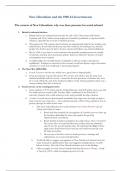New Liberalism and the 1905-14 Governments
The context of New Liberalism: why was there pressure for social reform?
1. Britain’s industrial decline:
a. Britain had lost its industrial lead towards the end of the 19th century (fell behind
Germany and USA), which caused employers/journalists/politicians to question british
efficincy, especially due to levels of endemic poverty.
b. Throughout the 19th century, there had been an unquestioned belief in free markets and
minimal state. It was believed that any man who wanted a job could get one, and that
people who lived in poverty did so because of personal failures (e.g. alcohol addiction).
c. But, by 1900, it was clear to social reformers that periodic unemployment was actually
involuntary, and that proto-Keynesian policies (based on Hobson’s theories of under-
consumption) were required.
d. Lord Beveridge: the ‘invisible hand’ of capitalism could not sustain a ‘prosperous
equilibrium’. Attempts to intervene in the economy would not depress wages and reduce
incentives to work, but would lead to increased prosperity.
2. The Boer War (1899-1902):
a. It took 3 years to win the war, which was a great blow to imperial pride.
b. Great government concern that almost 30% of men who tried to join the army were
declared medically unfit for service – raised the obvious questions of whether they were
fit to work efficiently, and of the medical condition of the whole population (there was a
strong working-class fear of doctors).
3. Social surveys on the existing poor laws:
a. Some students of T. H. Green and the Oxford historian Arnold Toynbee went to go and
live amidst poverty at places like Toynbee Hall, a settlement in the East End of
university students who could witness poverty and potentially develop solutions.
b. A series of social surveys demonstrated statistically that wages were not high enough to
keep everyone out of poverty — they estimated around a third of the population were in
poverty through no fault of their own.
i. The most vital publication for social reformers was Charles Booth’s Life and
Labour of the People of London:
1. Booth had first intended his investigation of London’s poor to shore up
the literature defending the status quo against the growing
‘impressionistic’ accusations.
2. Booth divided London’s population into eight classes. Class A involved
‘the lowest class of occasional labourers, loafers and semi-criminals’;
class H was the servant-keeping class. He calculated that four of these
eight classes lived below his poverty line and could not provide even
the basic necessities.
3. He was one of the first voices to attach poverty to earnings and
employment, not to personal depravities.
ii. Yet Booth did not suggest a programme of New Liberal style reforms from his
study. Instead, he upheld laissez-faire and suggested sending classes A and B
labour colonies. But other New Liberal reformers took on his findings.
iii. Other examples of social surveys include Seebohm Rowntree’s Poverty, A Study
of Town Life (1901), which investigated poverty in York.
, 4. The intellectual ‘progressive movement’ and the Rainbow Circle:
a. In the 1890s, a number of academics, journalists, and other professionals adopted the
label of ‘progressives’. Not all progressives were Liberal, just as not all Liberals were
progressives.
b. Liberal reformers and Labourites also came together in the Rainbow Circle.
i. Meeting of young Liberals, Fabians, and socialists in the Rainbow Tavern in
Fleet Street.
1. Hobson, George Gooch (a young 20 year old, later Liberal MP),
Herbert Samuel, Charles Trevelyan.
2. Also Ramsey MacDonald.
ii. Their aim was to provide a comprehensive view of political and social progress,
formulating a body of political and economic doctrine.
iii. It proposed specifically to explain why the Manchester School and Gladstonian
Liberalism could not longer stand.
c. These thinkers published their ideas in the Progressive Review (particularly Hobson).
i. William Clarke, the editor, was a Fabian; Ramsay MacDonald was with the ILP.
ii. This began to address the ‘social problem’ through a variety of channels:
philosophic, social, economic, political, and scientific thought.
iii. At this point, the Liberal party was still heavily associated with Benthamism and
the Manchester school, and the Progressive Review saw ‘no force in the claim of
the Liberals to be regarded as the progressive party of the future’.
d. The dialogue between thinkers in both the socialist and Liberal traditions was important
in providing some contextual basis for the later manifestation of a ‘progressive alliance’.
The use of the term ‘progressive’ in 1903 came to describe the alliance struck between
the Liberals and Labour.
e. Interesting to think about this point of intellectual dialogue in relation to the countering
point that the Liberals needed to confront the Labour electoral challenge.
➔ This all led to the growing conviction that, rather than being “the guardian of every other right”
(Ely), property rights generated an unjust inequality of power which reduced the liberty of the
working-classes.
➔ Freeden: there was a new recognition of “the connection between ethics and politics”, and the
need to “achieve the social good”.
o Lloyd George: “Let Liberalism proceed with its glorious work of building up the temple of
liberty in this country, but let it also bear in mind that the worshippers at the shrine have
to live”.
o Hobson: “the state should maintain a minimum standard of life for all its citizens and
operate certain economic functions for the community as a whole”.




